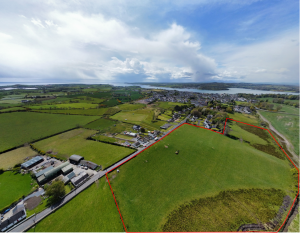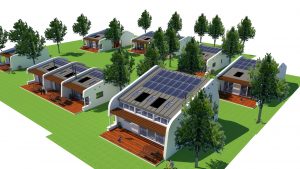
Ireland’s first co-housing community is about to become a reality. Co-housing is a concept that was first started in Denmark in the 1960’s among people who wanted a living environment with community at its core, whilst at the same time wanting to live more sustainably, where the design of the project and decisions about running it are community-led. It therefore has elements of an intentional community as well as of an eco-village. About 1% of the population of Denmark now live in such communities and it has spread internationally. There are currently some 30 live projects in Britain and 60 in development, but no live projects so far in Ireland, although there are a few groups working towards that aim.
This is about to change, as Portaferry Co-housing has purchased a 13.5 acre plot on the outskirts of the County Down town of Portaferry last year and is in the final stages of the design process in readiness for submission to the planning authorities. So what is this all about, I hear you ask.
Co-housing Principles
-
The members of the project participate in both the physical design and how they are going to live together.
-
It includes both private residences, owned or rented, and communal facilities, such as a common house, communal gardens and other green spaces.
-
The size is appropriate for communal dynamics, typically 12-32 households. In our case we are planning for 32 residences of varying sizes for mixed generational occupants.
- Residents manage their own community, looking after maintenance, finances, gardening and organising shared activities. The Community is governed in a non hierarchical way, using consensus decision making
- Co-housing communities are inclusive and part of the wider community. They look to engage with their neighbours and the wider world.
The Project so Far

Many of the design features have been made along permaculture principles, especially in the landscape design. We have employed an architect with experience in sustainable architecture, who helped us come up with a practical and elegant design. The 32 residential homes will be located along contour lines of the gently undulating site, their living areas facing directly south to maximise passive energy absorption. At the centre stands the common house, which is designed for communal eating with a kitchen, play room for children, laundry facilities, hot desk office facilities, guest rooms and reception. This will offer economy of scale and reduces the need for some facilities to be housed in the private residences, which are therefore slightly smaller than traditional housing.
Parking is centralised, allowing most of the development to be pedestrianised and it is anticipated that households will share vehicles and electrical charging points will be available. House shapes are designed to maximise south-facing roof space for solar panels. Due to the large size of the exisiting site, there is ample space for planting. 1500 native trees have already been planted along the boundaries and also the beginnings of a food forest. There will be a communal food producing garden, complete with polytunnels, and there will be recreational areas for children and outdoor meet-ups as well as woodland walks.
Portaferry is a friendly small town at the end of the Ards Peninsula, about 30 miles south of Belfast. It enjoys a particularly clement micro-climate, being surrounded by 2 bodies of water, Strangford Lough and the Irish Sea, and being in the rain shadow of the Mourne Mountains. Shops and local facilities are all within easy walking/cycling distance of the site.
The project is entirely resident-led and all members will automatically become directors of the non-for-profit company that has been set up. We have had weekly Zoom meetings over the last year and a half and decisions are made on a consensus basis. Permaculture principles have also been influencing some of the decision making.
How can I get involved
If this sounds interesting to you so far, we are currently looking for more members to get involved. House sites are going to be for sale and there are will also be sites available to rent, for those who cannot afford to buy, or just want to dip their toes in before committing. There is also an option to self-build, as long as it fits in with the general design. An effort has been made to make prices as affordable as possible. In case of renting, there is agreement to extend statutory tenant’s laws, ensuring tenants cannot be evicted without good reason and no unreasonable rent increases are going to be implemented, the details of which still need to be finalised.
To become a member the current process is to first attend an orientation session with an existing member to get you up to speed on the process so far, then to attend our regular meetings for some time, to ensure your ideals are aligned with ours (or vice versa).
Want to know more?
For your first port of call, check out the website on https://www.portaferrycohousing.org/. If you have more questions you can message that page or message me on here, which will come directly to me.
